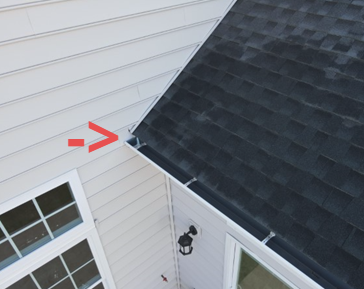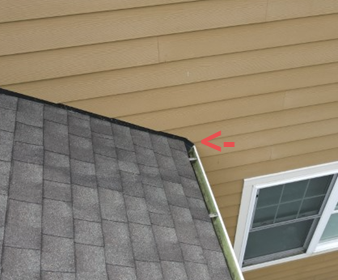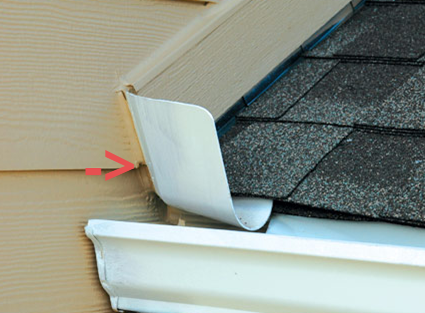<-- This photo was taken at a newly built home that I recently inspected for the buyer. Kickout flashing was missing at numerous locations. Notice the area just above where the gutter terminates against the siding. Kickout flashing should exist at the roof’s lower edge corner. The home had already passed the township’s code compliance inspection. The code official was actually doing a final walk-through before closing while I was onsite performing the buyer’s home inspection. When I asked the code official about the lack of kickout flashing in these multiple areas, his reply was “I am not too familiar with those requirements.” I was somewhat, understandably, shocked at his response.
Missing Kickout Flashing - A Common Defect

When inspecting the exteriors of homes, one of the most common flaws that I seem to find is missing kickout flashing. Roof flashings help prevent water entry into the home. Roof flashings are needed where there are changes in roof angle, at roof penetrations (such as chimneys and plumbing stack pipes), and where roofs join sidewalls or chimneys. In many cases, once a roof covering is installed, the roof flashings are no longer visible.
For homes that have a roof terminating against a lower side wall, kickout flashing is needed. To better illustrate this, think about the end of a gutter terminating laterally adjacent to an exterior side wall. Kickout flashing is needed just above the gutter’s end cap in order to help prevent roof runoff from passing between the gutter’s end cap and the home’s siding. The first 2 photos below are good illustrations of such an area. The lack of proper flashing can allow damage to the siding below this area to occur and may also allow hidden water damage into the adjacent exterior wall below this area. If a gutter terminates against a chimney, kickout flashing should also be installed just above that junction. It’s called kickout flashing because, in essence, as water runs down the roof along a side wall, this flashing kicks the water outwards towards the gutter and away from the gutter’s end cap junction with the siding.
Kickout flashing (also called “sidewall flashing”) has been required since the 2009 IRC (International Residential Code). I’ve seen many photos over the years of contractors called in to repair homes that have extensive water damage, rot, and mold due to years of water runoff onto exterior walls that can be directly linked to missing kickout flashing. The original wording of this flashing requirement in the 2009 IRC was somewhat vague and confusing to some. The wording changed in later code cycles [the IRC is updated every 3 years] to make it perfectly clear to builders, roofers, siding installers, remodelers, home inspectors, code inspectors, etc. that kickout flashing is needed at these areas.
-Copyright © Missing Kickout Flashing A Common Defect, Matthew Steger, ACI, 2024. All Rights Reserved.
Facts, opinions and information expressed in the Blog represent the work of the author and are believed to be accurate, but are not guaranteed. The Lancaster County Association of Realtors is not liable for any potential errors, omissions or outdated information. If errors are noted within a post, please notify the Association. Posts represent the author's opinion and are not necessarily the opinion of the Association.

















